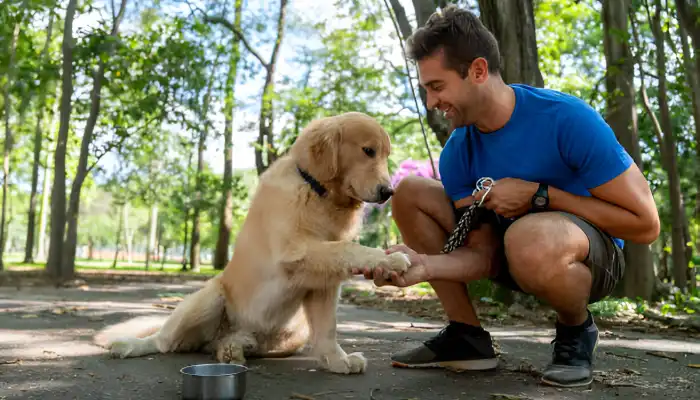If you’ve ever thought, “What’s Hello in Dog Language?”, you’re certainly not alone. As dog owners, we all wish we could understand our dogs’ gestures and expressions better. While we don’t have a dog translator handy to decode every sniff, tail wag, and bark, these expressions can help us better understand how our dogs feel and their communication styles.
In this blog, we will look at how dogs say hello using vocalizations and body movements.

Understanding Dog Greetings
Having a more in-depth look into, “What’s hello in dog language?”, dogs use their body language extensively. They don’t speak in words but rather use the entire body in expressing feelings, relations, and communication. Here’s a dog etiquette crash course to help you better understand how they greet other dogs or humans:
- Wagging their tails: Dogs wag their tails and that is a very common expression of saying hello. However, did you know not all tail wags are created equally?
- Barking: Dogs may yell to gain their owner’s attention or say an excited hi hos’ to say hello. An excited bark is usually friendly and more high pitched.
- Sniffing: Dogs love to sniff the ground, other dogs and even their owners as part of their greeting ritual.
- Body Posture: The body language of a dog gives us valuable insight into how to approach them. Relaxed posture with soft ears and open mouths usually translates to a happy, ‘greet me’ dog. On the other hand, stiff body language can also mean that the dog is apprehensive.
We understand the unexpressed “hello” they have for us when they offer us clues about their emotions.
How Dogs Greet Each Other?
Although dogs can greet each other in the same manner, it does depend on the nature-dog relationship they share as well as the other circumstances surrounding them.
Common Dog Greetings Between Dogs:
- Tail Wagging: Dogs wag their tails to greet each other. This is similar to humans raising hands to greet each other.
- Sniffing: In certain dog societies, sniffing each other’s rear end is seen as a “hello”. Dogs sniff each other’s butt as a means to understand and identify one another.
- Playful Behavior: A dog displaying feelings of playfulness might bow while placing his or her front legs down while raising the tail to utter a ‘hello.’
- Vocalizations: Dogs tend to vocalize through barking or other sounds to greet one another.
This may appear to differ from how two humans interact, however, the message is simple: an interaction is taking place.
Greeting Through Their Facial Expressions
It is hard to believe, however, dogs are able to communicate a great deal through their facial expressions. While attempting to answer the “What’s hello in dog language” question, we have to analyze their faces closely. A dog’s eyes, ears, and mouth can all show excitement, happiness or even nervousnes.
Some of the main facial signals are:
- Relaxed Eyes and Ears: A relaxed and happy dog is likely to have his eyes soft and ears relaxed.
- Raised Ears: The ears of the dog being responsive could make him look alert and ready to greet someone.
- Open Mouth with Slight Smile: When the dog is content or being playful, this is a perfect gesture to say “Hi”.
The next time your dog peacefully sits in front of you tail wagging while gazing at you, just know they might just be saying hi.
Communication Hello Through Barking
All of us have listened to our dogs home bark previously, but have you also come across the reality that not every barks are similar? Dogs utilize barking as a method of communicating a number of things like saying ‘hello’.
Classification of Barks and Their Meanings:
- Excited Bark: Single bursts of high energy which can be short or even sharp with their tails wagging. This would tell others that your dog is in a delightful mood to see you!
- Playful Bark: A fast, squeaky bark that tells you that your dog is in the mood for fun.
- Greeting Bark: At times, dogs carry out fa ew single barks or a single bark to greet their owners for coming back home.
“What’s hello in dog language?” Dogs have many ways of communicating with us, and barking is just one of them.
The Importance of Context
The first thing to consider when deciphering ‘What’s hello in dog language?’ The first thing you must always consider is context. Dogs are social animals and usually respond positively towards strangers, albeit cautiously.
Crucial Aspects That Affect Dog Greetings:
- Familiarity: Dogs enthusiastically greet humans and other animals they are familiar with.
- Mood: Tipsy, playful, and anxious dogs will greet differently depending on their mood.
- Setting: Communication from your dog might differ with respect to the place where the greeting takes place.
Context transforms meaning—never underestimate its power in every conversation.
Conclusion
As we have learned, each tail wag, sniff, bark, and even the expressive eyes of a dog convey a message. Even though dogs lack vocal language, they have an elaborate system of non-verbal cues to communicate greetings. Understanding these signals can be crucial in enhancing the relationship we share with our four-legged friends.
Therefore, the next time your dog meets you, take a moment or two to acknowledge that special greeting known to only them and appreciate that they are delighted to see you!
